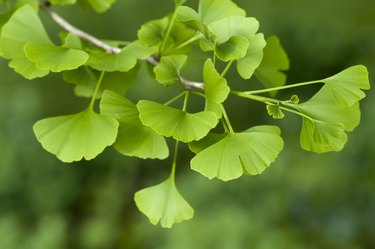
The ginkgo tree (Ginkgo biloba) is an ancient tree that's probably 180 million years old. Also called the maidenhair tree, it has distinctive, two-lobed leaves that turn bright yellow in fall. The tree comes in quite a few different varieties; some have distinctive growth habits, while others have unusual leaves or other interesting features, giving a gardener lots of choices.
Standard Male Varieties
Video of the Day
A ginkgo tree can be either male or female, called dioecious. Only female trees develop fruits, which are the size of plums, silver-orange in color, and have a strong, unpleasant odor. They can also be messy, littering the ground under the tree. Because of this, many cultivars available from nurseries are fruitless male trees. Examples include "Autumn Gold" (Ginkgo biloba "Autumn Gold"), which grows to 50 feet tall and 30 feet wide, and has strong yellow-gold color in fall. "Fairmount" (Ginkgo biloba "Fairmount") is another male variety that's narrow in form, up to 75 tall but only 15 feet wide. It has extra-dense foliage, but its fall color is less intense than "Autumn Gold." These trees grow in USDA zones 4 through 8.
Video of the Day
Dwarf Cultivars
Dwarf ginkgo trees are especially useful if you have a limited amount of space but would enjoy growing this tree. Examples include "Jade Butterflies" (Ginkgo biloba "Jade Butterflies"), which is a male tree that grows in USDA zones 4 through 8. It becomes only 6 to 12 feet tall when mature, and up to 9 feet wide. "Troll" (Ginkgo biloba "Troll") is an even smaller male cultivar, only 2 or 3 feet tall, with an equal spread. It has a shrubby, mounded growth habit and leaves that are the typical blue-green color of these trees during the spring and summer months; it grows in USDA zones 3 through 9.
Weeping Trees
Several ginkgo cultivars develop a semi-weeping shape as they mature. They belong to a group of trees called pendulous because of their drooping branches, which give them an extra-graceful form. "Mariken" (Ginkgo biloba "Mariken') belongs to this group. It's a male tree with weeping branches that's also slow-growing, becoming only 2 feet tall and wide after 10 years in the ground. "Pendula" (Ginkgo biloba "Pendula") can become about 8 feet tall when fully grown, although it's also a slow grower. Also a male tree, its branches first grow horizontally but eventually droop toward the ground as they get longer, giving the tree an umbrella-like shape. Both of these weeping trees grow in USDA zones 3 through 8.
Unusual Leaves
Several ginkgo varieties are standouts in the garden because of the interesting color of their leaves. One of these, the cultivar "Majestic Butterfly" (Ginkgo biloba "Majestic Butterfly"), is about 6 feet tall when 10 years old. Its unusual leaves are striped in green and cream to yellow during spring and summer, then turn bright yellow in the fall. "Snow Cloud" (Ginkgo biloba "Snow Cloud") has white blotches on its leaves that make the tree appear to be snow-covered when in leaf. It's about 10 feet tall and, along with "Majestic Butterfly," is a fruitless male tree that grows in USDA zones 4 through 9.
- Clemson Cooperative Extension: Ginkgo or Maidenhair Tree
- Sunset: Glorious Ginkgos
- Missouri Botanical Garden: Ginkgo Biloba "Jade Butterflies"
- Missouri Botanical Garden: Ginkgo Biloba
- Missouri Botanical Garden: Ginkgo Biloba "Troll"
- Missouri Botanical Garden: Ginkgo Biloba "Marikn"
- Missouri Botanical Garden: Ginkgo Biloba (Pendula Group)